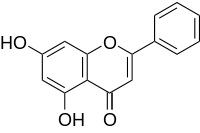
Chrysin is a naturally occurring flavone chemically extracted from the passion flowers Passiflora caerulea. Chrysin displays anti-inflammatory and antitumor properties. Chrysin inhibits HIF-1α (hypoxia-inducible factor-1α) and induces apoptosis. In vitro study shows that chrysin inhibits COX-2 expression and via IL-6 signaling, which may contribute to anti-inflammatory effects. Chrysin demonstrated cell toxicity and inhibition of DNA synthesis at very low concentrations in a normal trout liver cell line.

ACS Chem Neurosci. 2022 Feb 16;13(4):442-453.
Anti-α-synuclein Toxicity and Anti-neurodegenerative Role of Chrysin in Transgenic Caenorhabditis elegans Models of Parkinson's Disease
Chrysin purchased from AbMole
| Molecular Weight | 254.24 |
| Formula | C15H10O4 |
| CAS Number | 480-40-0 |
| Solubility (25°C) | DMSO ≥ 30 mg/mL |
| Storage |
Powder -20°C 3 years ; 4°C 2 years In solvent -80°C 6 months ; -20°C 1 month |
| Species | Mouse | Rat | Rabbit | Guinea pig | Hamster | Dog |
| Weight (kg) | 0.02 | 0.15 | 1.8 | 0.4 | 0.08 | 10 |
| Body Surface Area (m2) | 0.007 | 0.025 | 0.15 | 0.05 | 0.02 | 0.5 |
| Km factor | 3 | 6 | 12 | 8 | 5 | 20 |
| Animal A (mg/kg) = Animal B (mg/kg) multiplied by | Animal B Km |
| Animal A Km |
For example, to modify the dose of Compound A used for a mouse (20 mg/kg) to a dose based on the BSA for a rat, multiply 20 mg/kg by the Km factor for a mouse and then divide by the Km factor for a rat. This calculation results in a rat equivalent dose for Compound A of 10 mg/kg.
[4] Saima Naz, et al. Chrysin: Pharmacological and therapeutic properties
| Related Cytochrome P450 (e.g. CYP17) Products |
|---|
| Cytochrome P450 reductase
Cytochrome P450 reductase is a NADPH-cytochrome reductase. |
| 20-SOLA
20-SOLA is a water-soluble 20-HETE antagonist. |
| TS-011
TS-011 is a selective inhibitor of 20-hydroxyeicosatetraenoic acid (20-HETE) synthesis. |
| Dibromo-dodecenyl-methylsulfimide
Dibromo-dodecenyl-methylsulfimide is a selective inhibitor of 20-HETE synthesis and attenuates the vasodilatory response to sodium nitroprusside (SNP). |
| Abiraterone decanoate
Abiraterone decanoate is a novel, long-acting Abiraterone precursor compound that also exhibits high CYP17 cleavage enzyme inhibition selectivity for prostate cancer related studies. |


Products are for research use only. Not for human use. We do not sell to patients.
© Copyright 2010-2023 AbMole BioScience. All Rights Reserved.
